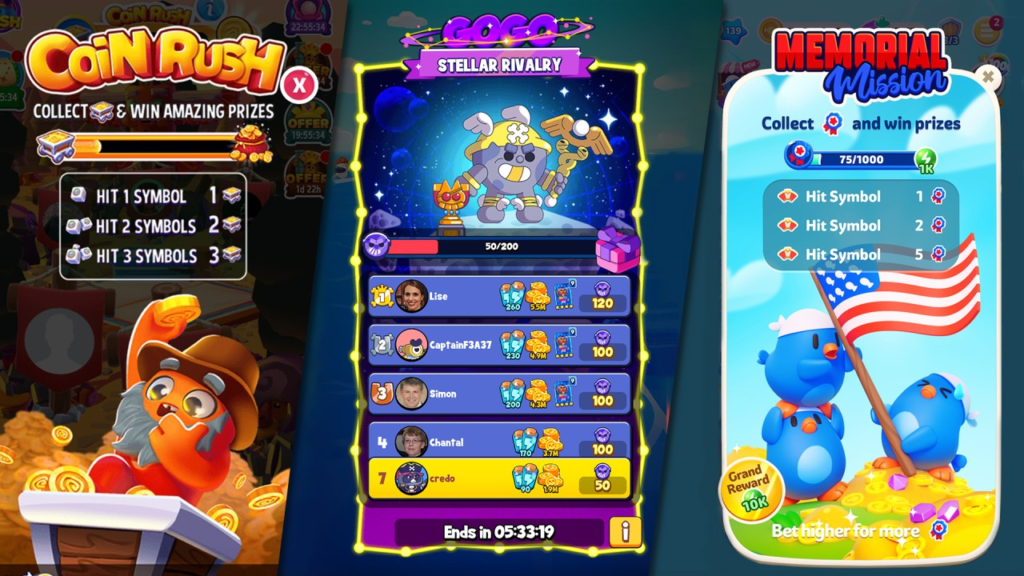About the author
Michael Kopelovich
I deliver weekly insights on game monetization strategies, reviews with a focus on revenue, and tips on marketing and creative design.

Journal 4 Michael Kopelovich May 28

These events, popular in games like Coin Master, Monopoly Go, and Dice Dreams, offer players a series of milestones to achieve, each providing exciting rewards. This article delves into the mechanics and benefits of milestone-based live ops events, highlighting their structure, implementation, and customization.
Through detailed examples and insights, we’ll explore how these events keep players coming back for more.

One of the defining features of successful social casino games is the constant presence of live ops events. These games ensure that there is always at least one event live at any given time. By scheduling events to usually last between 24 to 96 hours, developers maintain a steady stream of engagement opportunities for their players.
To understand better the behavior of this type of event, I used the LiveOps & Updates Calendar provided by AppMagic, which currently tracks over 170+ top-grossing games you can search and analyze. As you can see in the image below of Coin Master’s calendar, there are around 6-8 different events live at any given moment. This consistent scheduling keeps players engaged and encourages continuous play. However, our focus in this article is to understand better the specific event highlighted in red.

Introducing live ops events during the First-Time User Experience (FTUE) can significantly enhance player retention. Dice Dreams provides an excellent example of this strategy by integrating live ops events into their FTUE. This early exposure ensures that new players immediately understand the value and excitement of these events, creating an immediate incentive for continued play. By showing new players the rewards they can earn from the start, developers boost initial engagement and set the stage for long-term retention.

This type of event typically comes in two flavors: solo play and leaderboard-based competition. In solo play events, players progress through milestones on their own, earning rewards based on their achievements. This mode is perfect for players who prefer a more relaxed, self-paced experience.
On the other hand, leaderboard events add a competitive element to the mix. Players still complete milestones to earn rewards, but they also compete against others for a spot on the leaderboard. The top performers receive additional rewards at the end of the event, providing extra motivation for players to engage more deeply.
Many games often use a mix of both approaches. Sometimes, they offer solo and leaderboard events simultaneously, allowing players to choose their preferred mode. At other times, they rotate between solo and leaderboard events, keeping the gameplay dynamic and varied.



In milestone-based live ops events, players earn experience points (XP) for completing various in-game actions, such as stealing, attacking, or achieving perfect scores. These actions and their corresponding XP values vary from game to game, creating unique experiences for players.
For example, a typical XP rule set might look like this:

Some games might place a higher value on competitive actions like attacking, while others might reward strategic play or collaboration.
Understanding these variations can help developers fine-tune their live ops events to match their game’s goals and player preferences. By analyzing the most effective XP rules from popular games, you can optimize your own events to maximize engagement and satisfaction.
Milestone progression is a crucial aspect of live ops events. The difficulty curve of milestones plays a significant role in maintaining player engagement. Most games use a non-linear progression, where the difficulty of milestones fluctuates between easy, medium, and hard levels.
A typical progression might follow this pattern:

By analyzing the XP needed for each milestone, developers can create a balanced experience that keeps players motivated without overwhelming them. This approach is similar to how match-3 puzzle games balance challenging levels with easier ones to maintain player interest and reduce churn.
One of the significant advantages of milestone-based live ops events is their flexibility and ease of customization. Developers can tailor these events to fit various themes and occasions, enhancing the overall player experience and keeping the content fresh and engaging.
Customizing events usually involves designing a single screen with a unique visual theme that can be adapted for different holidays or special occasions. For example, a summer-themed event might feature a beach backdrop and tasks related to collecting beach items, while a Halloween event might involve spooky elements and tasks centered around collecting pumpkins or ghosts.
Here are a few examples of how games have successfully customized their milestone-based events:

Themed events can create a sense of novelty and excitement, encouraging players to return to the game regularly to see what’s new and participate in limited-time challenges.
By leveraging the flexibility of milestone-based events, developers can continuously provide new and engaging content, ensuring that players always have something to look forward to.
Milestone-based live ops events are a powerful tool for driving player engagement and retention in social casino games. By understanding the mechanics of these events, incorporating them effectively into the FTUE, and customizing them for various themes and occasions, developers can create a dynamic and engaging player experience. These events not only boost player activity but also offer valuable opportunities for monetization and long-term player retention.
About the author
I deliver weekly insights on game monetization strategies, reviews with a focus on revenue, and tips on marketing and creative design.
Please login or subscribe to continue.
No account? Register | Lost password
✖✖
Are you sure you want to cancel your subscription? You will lose your Premium access and stored playlists.
✖